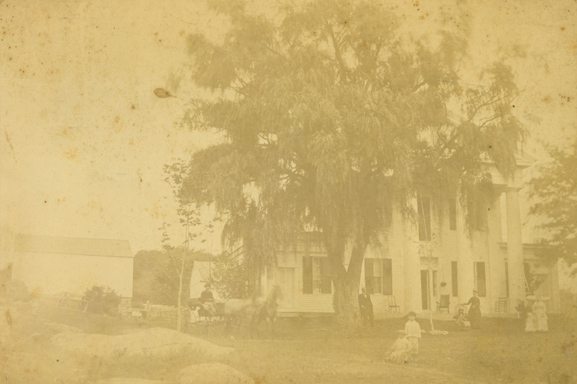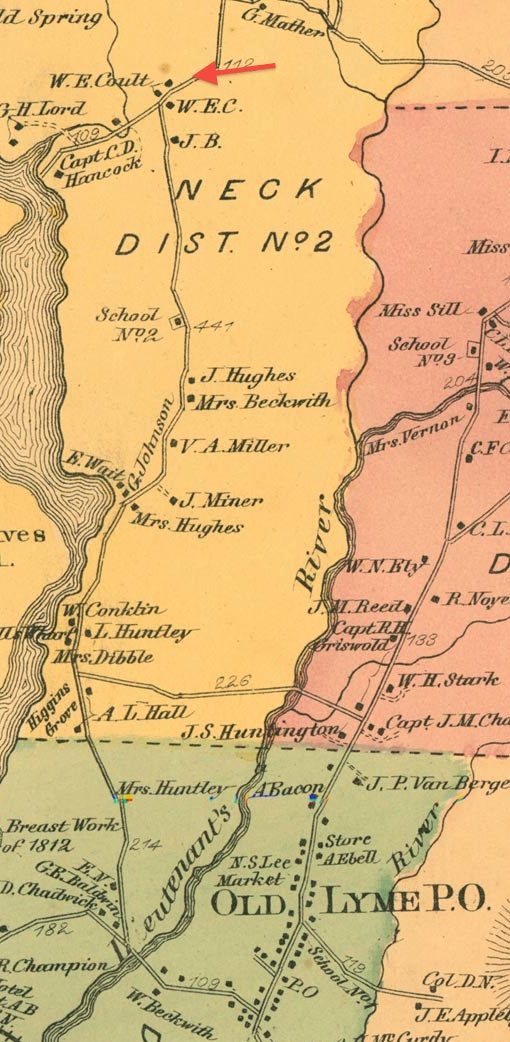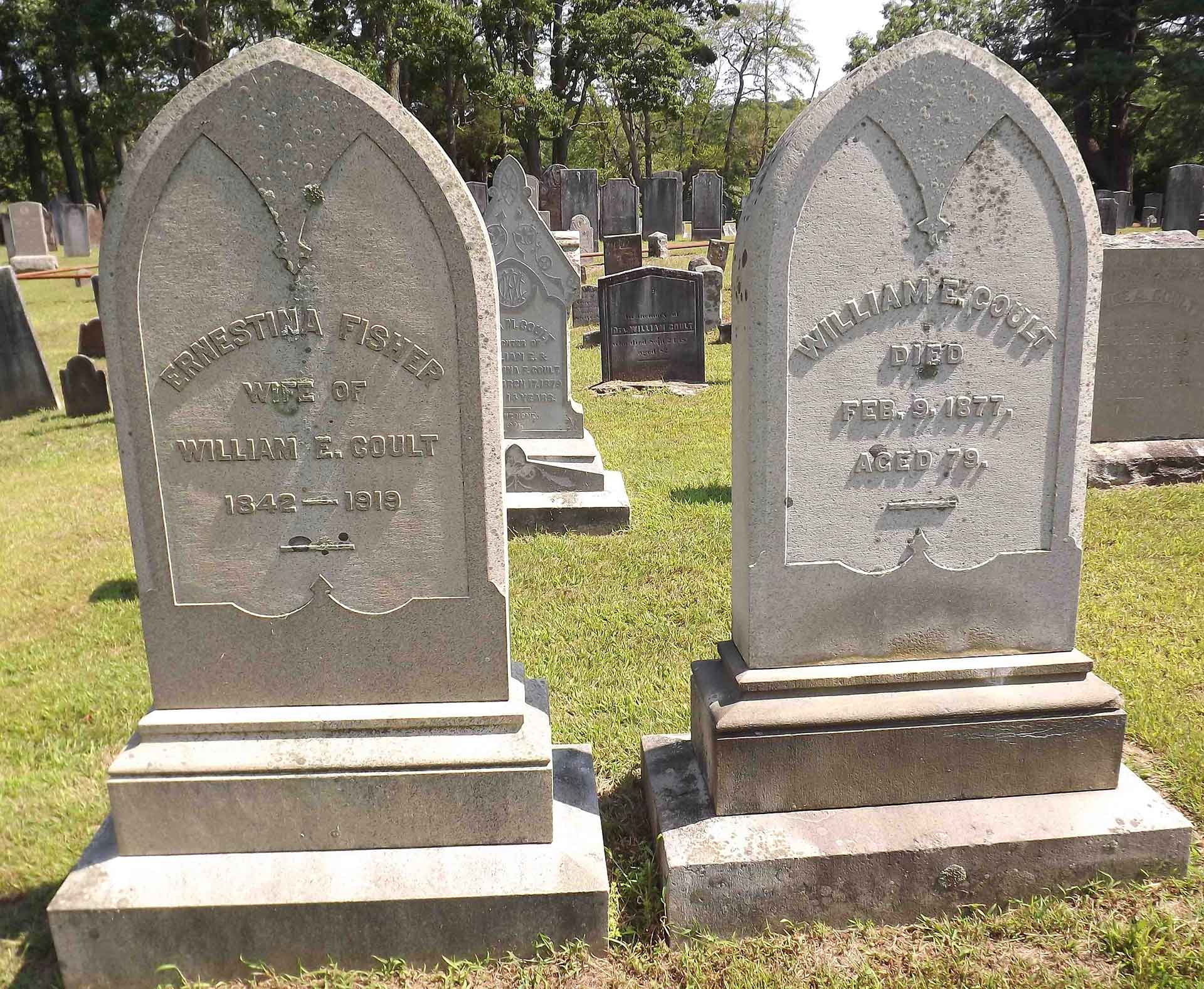
by Charles Beal
Featured Photo (above): Ernestina Fisher Coult, ca. 1905. LHSA
Old Lyme’s prominent families traditionally used marriage ties to extend their property, wealth, and status. William Ely Coult (1797–1877) ignored that precedent when at age 65 he married the young German woman who worked as his household servant.
Arriving from Prussia
In the summer of 1854, Ernestina Fisher, age 12, and her family said good-bye to their friends and relatives, left their home in Silesia, a region of Prussia near the border with Poland, and journeyed to Hamburg, Germany, to seek passage to the United States. Traveling with few possessions, the Fisher family group of ten, including an infant son, boarded a relatively small merchant ship, the Isaac Allerton, in Hamburg with 246 other passengers. After a long voyage, likely in cramped quarters with poor food, limited ventilation, and crude sanitary conditions, the ship arrived in New York harbor in October of 1854.[1]
Albert Fisher, Ernestina’s father, was looking for opportunity in the United States as had Isaac Allerton (1586–1658) for whom the sailing ship was named. After arriving on the Mayflower 234 years earlier, Allerton became a prominent member of the Plymouth colony. The square-rigged packet ship bearing his name was built in 1838 at Portsmouth, New Hampshire, by Master Carpenter George Raynes. Two years after the Fishers’ voyage, the Isaac Allerton, which measured 137 feet and weighed 594 tons, sank near Key West, Florida. Artifacts from the ship are now on display at the Key West Shipwreck Museum.[2]
During the 1850s in Germany, dramatic changes were occurring that likely prompted the Fisher family’s emigration. A failed revolution took place across Europe in 1848, bringing about a shift in national boundaries that impacted Silesia and many other areas. There was considerable social unrest and long-term economic hardship. Over the next ten years more than a million people left Germany and settled in the United States. Some were the intellectual leaders of the rebellion, but most were impoverished Germans who had lost confidence in the government’s ability to solve the country’s economic problems. Others left because they feared continuing political turmoil.[3]
After landing in New York, Albert Fisher moved with his wife and children to Lyme, possibly by means of the newly established railroad service, in response to a need for domestic servants in the homes of prominent families, a need that Ernestina and her sisters filled, and for farm labor, a need filled by her father and brothers. While Ernestina became a servant in the home of William E. Coult, her sister Augusta and brother Augustus worked in the nearby Tantummahaeg household of Mrs. William Lord.[4]

Railroad bridge at Ferry Point. LHSA

Coult family homestead. LHSA

William Lord house, Tantummahaeg. LHSA
Marriage provided fresh opportunity for two of Ernestina’s sisters when they received proposals sent by letter from suitors in Oregon. Their parents, wishing to draw the family closer together, moved West to live near the married sisters. Handwritten notes, unsigned but apparently prepared by a sibling, explain: “Mother did not like the family separated so they sent for us to come West that Father might take up a homestead.” But Mrs. [Mary Marvin] Coult “would not agree to parting with Ernestina & induced Wills father [William E. Coult] to keep her there.” [5]

Mary Marvin Coult. LHSA

William Ely Coult. LHSA
Settling in Lyme
The Coult family were among Lyme’s earliest settlers. Captain John Coult (1658–1751), born in Windsor, likely arrived prior to his marriage to Sarah Lord in 1687. He was followed in a direct line by Deacon Benjamin Coult (1699–1756), Captain John Coult (1725–1784), and William Coult (1776–1858). By the time William E. Coult was born in 1797, the family property included nearly 300 acres in the section of town now called Tantummahaeg.

Town of Old Lyme (detail showing W. E. Coult house), F. W Beers, 1868. LHSA
An active member of the church and the community, William E. Coult had been raised by his father’s second wife Mary Marvin Coult (1776–1867). He became a mathematics teacher as a young man, and in 1823, the same year he received a commission in the Third Infantry Regiment of the Connecticut militia, he earned a salary of $12.00 per month from the First District School in the center of the village.

William E. Coult, certification as teacher, 1817. Coult
Papers, Box 2. LHSA

William E. Coult’s Book, showing mathematics lesson on
measurements of wine. Coult Papers, Box 2. LHSA
Later, while helping his father manage the family farm, W. E. Coult served for many years as secretary for the Second School District, which extended up the Neck Road. He also ventured into mercantile trade and purchased a steamboat, the Middlesex, but he never married. It was likely the death of his father in 1858 that prompted him to hire the young German immigrant Ernestina Fisher to assist with farm and household tasks.[6] Five years later in December 1863, after Ernestina had reached the marriageable age of 21 and joined the church, she became the wife of her elderly employer.
By 1871 the Coults had three daughters and a son. Their children attended the private Lyme Academy and participated in a dancing class at the newly opened Pierpont House hotel. Calling cards saved among the family papers indicate that Mr. and Mrs. Coult entertained many of Old Lyme’s prominent residents. But not long after their youngest child William Fisher Coult (1871–1936) turned six, his father died at age 79.

Report card for Mary E. Coult, Lyme Academy, 1877. LHSA

Invitation, dancing class, Pierpont House, 1876 LHSA

Calling card, Mr. Edward E. Salisbury, Miss Evelyn McCurdy,
married at Lyme 1871. LHSA
Inheriting the Coult Estate
Ernestina Fisher Coult was 34 when she inherited her husband’s estate, valued at $37,901. In addition to the farm and its buildings, the estate inventory lists bank shares, bonds, and promissory notes; livestock (10 yoke of oxen, 13 cows, 5 steers, 2 Devon bulls, 5 heifers, 9 calves, 72 sheep); 33 tons of hay; farm implements (among them a plough, a mowing machine, and a scow); and household furnishings that included a piano forte and a silver tankard with five large silver spoons.
Assisted by hired workers, the young widow managed the Coult farm with thrift and efficiency while continuing a range of social activities with neighbors and friends. Her account book in 1878 lists eggs sold for 35 cents a dozen, hens sold for 50 cents apiece, “$7.49 worth of Turkeys,” as well as corn and oats sold by the bushel. Additional earnings came from the sale of butter, vinegar, potatoes, wool, wood, sheep, and pigs.[7] A diary entry in 1881 notes: “January 1st very pleasant. All well, very cold. 2d Sunday went to church in sleigh, six of us, pleasant. 3rd washed, fine day, called on Gusta & Fannie Clark, in the evening called on Mrs. N.”

Coult farm, looking east from Tantammuhaeg, ca. 1890. LHSA

Mrs. Coult, Mrs. Henry Noyes, Miss Coult (center), clam bake, 1898. LHSA

Calling card, Mrs. E. F. Coult. LHSA

Mrs. Coult with daughters Mary & Abbie, Mrs. R. S. Griswold, Miss Josie Brown, unidentified child, at Judge McCurdy’s home, ca. 1890. LHSA
After her husband’s death Mrs. Coult drew on the cultural resources of Old Lyme to provide a privileged education for her children, including at the Griswold Home School. Her account book entries in 1880 record a tuition payment of $12.00 to Florence Griswold; a payment of $20.00 to Miss Lou Griswold for music lessons, “one quarter for Anna one for Mary”; and a payment to “Miss Gilette Tuition $7.75 For Willie 1880.” In about 1885 Mrs. Coult sent her son to board at the nearby Black Hall School that prepared young men for college.

Lyme Academy receipt for fees paid, 1882. LHSA

William F. Coult’s room at Black Hall School, ca. 1885. LHSA
Her engagement in social activities continued in her later years, and in 1915 she joined, with Florence Griswold and other prominent town women, the newly established Old Lyme Branch of the Connecticut Association Opposed to Women’s Suffrage. When she died four years later at age 77, having outlived her three daughters, an obituary in The New Era on October 17, 1919, reported that she was “always bright and active up to the time of her last illness and to the end she was able to continue her lifelong habits of usefulness, charity and honor.” [8]

Coult gravestones, Duck River Cemetery, 2012. Photograph by Charlie Beal
But while Ernestina assimilated fully into the social life of Old Lyme’s landed families, she also passed on to her children a connection to their European heritage. The census report in 1910 notes that Abbie A. and William F. Coult both spoke German.

W. F. Coult house, ca. 1925. LHSA
[2] See information provided by the Key West (FL) Shipwreck Museum
[3] See Mary Fulbrook, A Concise History of Germany (Cambridge University Press, 1990), pp. 117-123.
[4] Unsigned family notes, Coult Collection, Box 1, LHSA.
[5] Coult Collection, Box 1. LHSA.
[6] The census report in 1880, when Ernestina’s neighbor Henry Noyes was the enumerator, lists Holland as her country of birth.
[7] William E. Coult, Estate Inventory; Ernestina Coult, Account Book, Coult Collection, Box 1, LHSA.
[8] The Deep River New Era, Ocober 17, 1919.





